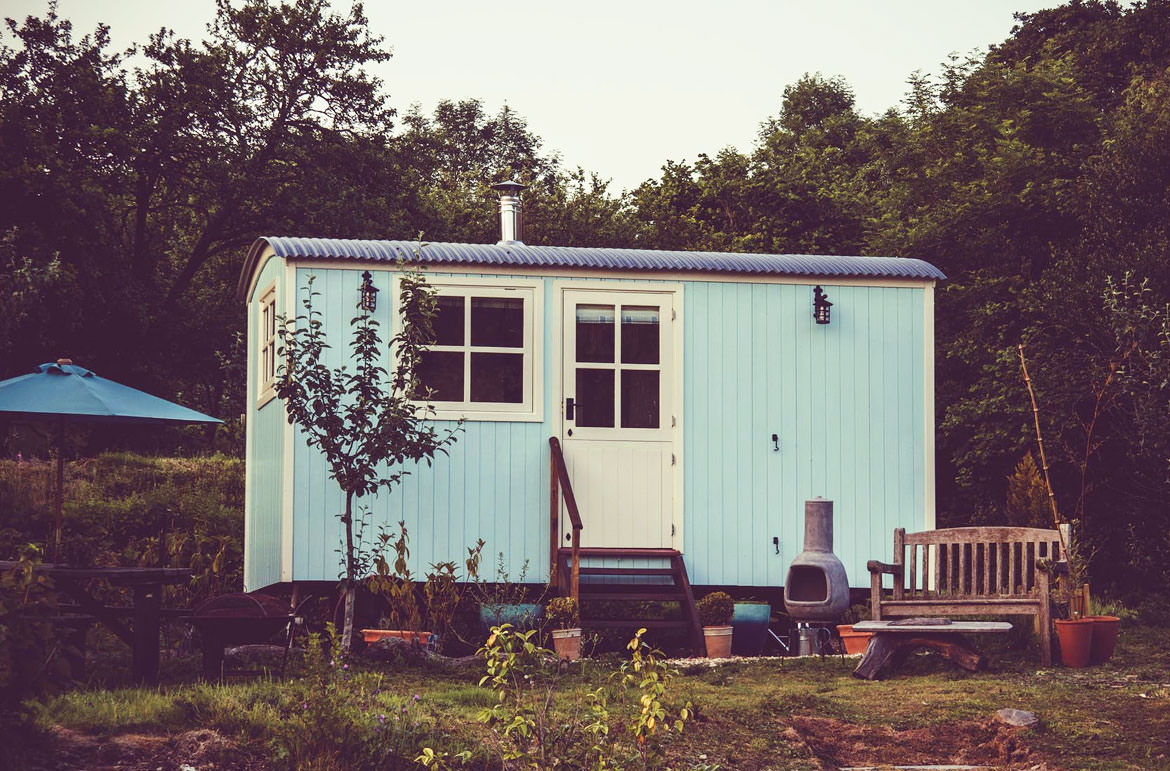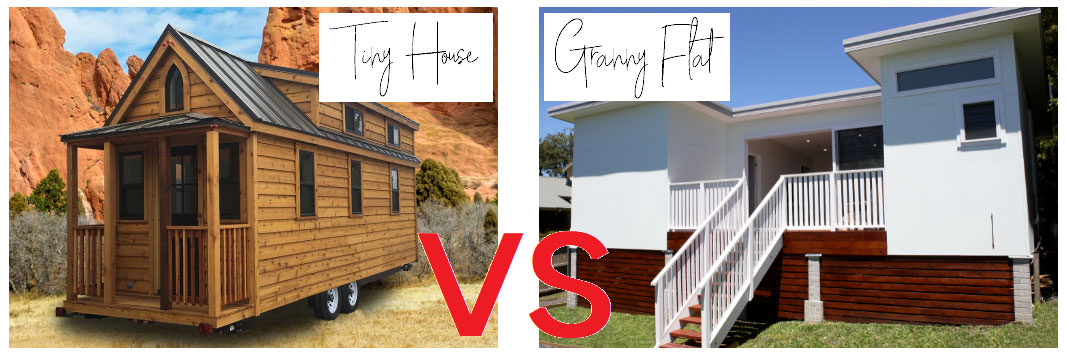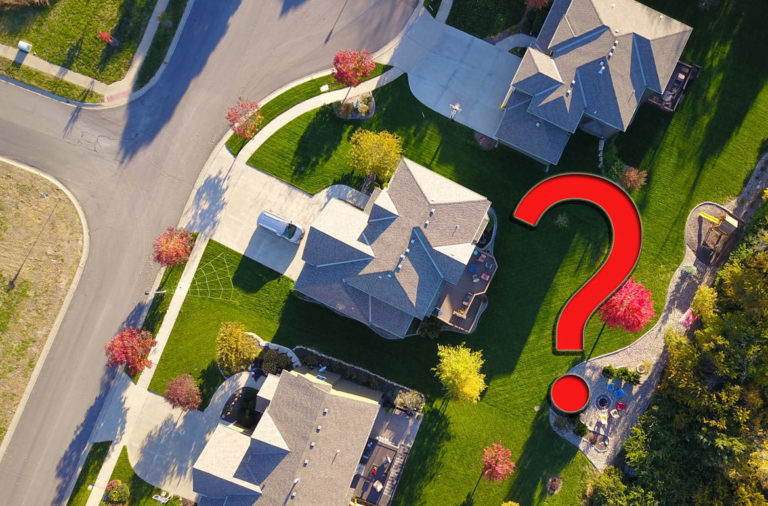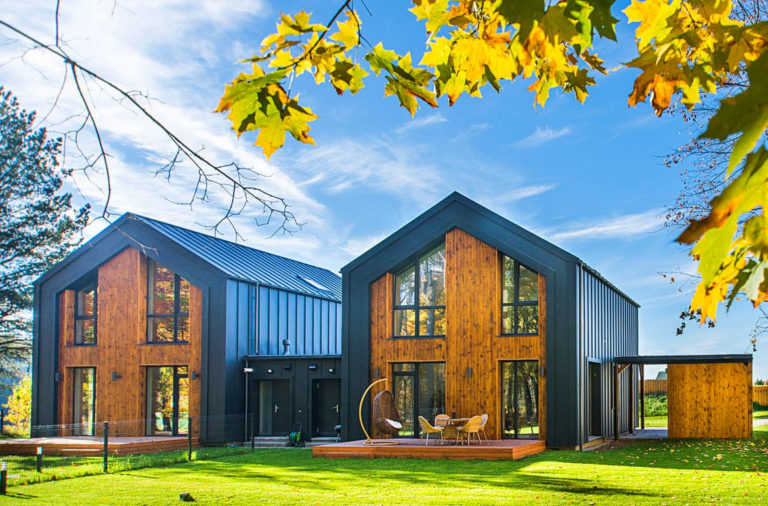
The tiny house movement has been an uprising trend for a few years now, at the same time as which granny flats are becoming more popular than ever. Which may leave you wondering – What is the difference between a granny flat and a tiny house?
Tiny houses are a compact, transportable dwelling, and an affordable option. Granny flats, (generally larger) are a fully self-contained, comfortable home with up to 3 bedrooms, and still an affordable residential option for those looking for accommodation in today’s property market.
After all, according to International housing group Demographia, Australia has been listed as a severely unaffordable housing market.
So, any option within your means may be worth exploring.
Today I will discuss the granny flat versus the tiny house – the differences between each, and the benefits of both, to help you choose what option is right for you.
DON'T PAY A FORTUNE FOR YOUR GRANNY FLAT. Find out how to deal with council and build a granny flat for the lowest cost possible. Learn More.
What are other differences between a granny flat and a tiny house?

A granny flat is a self-contained “house”, usually built on the grounds of a family home.
Often detached from the other home, although sometimes attached via either interior or exterior walkways, the granny flat has enough space for 1 to 2 people to live comfortably.
They also have room for visitors or more storage space, as granny flats can have up to 3 bedrooms.
Different states and their local councils have different rules as to the maximum size allowable, ranging from 60 to 80 square metres, and up to two-storeys high.
Be sure to check with your local council as to the rules for the maximum size allowed for a granny flat in your habitable space as these vary from council to council.
Granny flats have many advantages, including:
- They have higher levels of comfort – Modern granny flats don’t go without comfort.
Requirements that are met include insulation, cooling, heating, and lavish outdoor spaces as well as spacious indoor living areas.
- You can get finance for a granny flat if required – Lenders will provide finance for a granny flat, whereas they probably won’t lend for a moveable structure such as a tiny house, as it’s not a fixed asset.
- There are a range of design options – You are not restricted to a standard design, but instead have a range of design options to choose from.
You can make changes to the design of a granny flat, such as personalising the colours and finishes and even hiring an interior designer to assist.
You can even choose to design your own unique granny flat.
This means that, regardless of what option you choose, the granny flat will match the style of your existing house.
- It can affect the resale value of your property – In a good way, that is.
With prices of houses soaring in Australia, most buyers view a property that has the ability to spread the costs an attractive option.
With a granny flat, if your council allows, you can take on tenants to help pay the mortgage.
Or you can choose to share the home with your family, providing mutual care and support between family members.
With less of the elderly choosing to live in retirement homes (the number having dropped from 39% of Australians aged 85 or older in 1999 to 26% in 2011), they can live close by and have a safety-net for emergencies, or with more children choosing to live with their parents for longer, they can escape into their own space but still live close by while saving money for their own accommodation.
It even gives families who hire a nanny the option to provide separate, self-contained staff accommodation.
Granny flats though, do come with their disadvantages:
- They will require costly and complex permits and certifications – These too tend to vary from state to state and council to council, so it is best to check with your local council first as to exactly what your requirements are, before going ahead and building your granny flat.
But one thing is for sure – building a granny flat is going to require costly and complex planning permit applications, with costly consultants, and this will add to your costs and waiting for approval will slow you down.
These are required as granny flats are fixed to the land, which provides ongoing costs and no flexibility – it’s not as if they can just be picked up and moved.
A tiny house is, as the name suggests, a tiny house – it is a moveable dwelling up to 50 square metres maximum.
They are built on wheels in an attempt to face the housing affordability crisis in Australia – as much of this is a result of the demand for land.
The idea behind the tiny house is their flexibility – if you build a house on wheels, it separates house from land, freeing the tiny house from some of the pressures of the housing market – that is, making them more affordable as you do not have to purchase land.
You can choose between an “off the grid” style tiny house, which comes with a composting toilet, solar panels and water tank, so you can relocate your tiny house anywhere.
Or there is a residential option, which you can connect to your existing home’s plumbing and electricity.
Despite their size, tiny houses do have their advantages:
- They are easily relocatable – They are built on a trailer base, so you are literally experiencing living on wheels.
This allows you a freedom to live a life in changing destinations.
However, keep in mind that this kind of lifestyle does not suit everyone – more on this later.
- They are built on a solid structure – The trailer base they are built on is a solid foundation, so they do not need any further structural support or permanent service connections.
- They are an affordable option – If you don’t have enough money for a house deposit and don’t want the financial obligation of a mortgage, which many people cannot afford in this day and age, they may be an option worth considering.
- You also save on bills – Living in such a small area means the house is cooled and heated easily – a ceiling fan in the living area and sunroof is all it takes to release the heat, and an oil heater is all it takes to warm the entire ho
- They do not require the costly and complex permits, certifications and approvals of a granny flat – As the tiny house on wheels is a moveable dwelling, it is technically classified as a “caravan”.
As it is not a fixed dwelling, you do not need to complete all of the applications to gain all the permits and get all the approvals that you would if you were to build a granny flat – after all, a caravan does not require a planning permit to park on your land, and a tiny house is registered to travel on the road similar to a caravan.
However, tiny houses definitely also have their fair share of disadvantages;
- They are tiny – At no bigger than 50 square metres it’s not much bigger than a caravan and they are generally designed with the living area downstairs and the bedroom upstairs.
You can basically forget about having friends or family over to stay as there simply is no room. But if you prefer living along or are a couple that doesn’t mind, then who cares 🙂
- Parking can be a problem – When looking to make a change and thinking about where to park, you need to think about the height of the house and whether overhanging trees could be an issue.
You also need to think about easy access to things such as laundry facilities.
- Tiny house equals tiny consumption – Limited storage space means keeping everything to a minimum, from your wardrobe to your kitchen, pantry and beyond.
- It’s a fragile state of housing – Those who live in a tiny house have suggested that you are generally always aware of the wheels underneath you, as there is a slight swaying when climbing the ladder upstairs.
As they are not grounded but instead detached from the Earth with wheels underneath them, it’s a constant reminder of being in a delicate housing situation, which isn’t always an ideal for everybody to live.
- The legalities around tiny houses in Australia are complicated – Read “Can you legally live in a tiny home” below for more information.
Can you legally live in a tiny home?
The legalities around tiny homes remain complicated!
Basically, there are no specific regulations surrounding tiny houses in Australia.
The main obstacle for anyone wanting to live in a tiny house in Australia is navigating your local councils’ regulations.
Local laws differ from council to council and depend on a variety of things, such as the size of your tiny house and whether it’s on wheels.
As tiny houses on wheels are considered “caravans” they do not require council approval.
If your tiny house is on wheels it is not a fixed structure, so you can basically park it anywhere from your block of land to a friend’s farm.
However, councils can limit the amount of time you can permanently live in one.
This rule may vary between states and from council to council.
It can be daunting knowing where to start but contacting your local council will help.
There are also some basic rules you should follow;
- Weight restrictions – Keep your house under 4.5m high, less than 2.5m wide and no longer than 12.5m, because, to legally tow your tiny house on our roads, it must be under 4.5 tonnes.
It’s also a wise idea to check that your vehicle is capable of towing something that may end up weighing more than 4 tonnes.
- Design – A tiny house can technically be anything from a special house built on wheels, to a caravan, to a teeny little house built on-site.
But in general, the most popular version of tiny houses are those built on wheels.
This is because if the house is on a trailer, it is no longer classified as a building, as it is not a permanent structure, and so building codes and permits typically do not apply – although it does pay to check with your local council as to their exact regulations.
Building on-site, so making your tiny house a fixed structure, does require council approval and applications, which takes time and money, and may not be legal with your local government.
If you haven’t gotten the proper approval before building your tiny house on land you’ve taken a big risk as the council could actually come and rip it down.
Whereas if your house is on wheels, you can just move your house elsewhere.
- Council regulations – There are only a few local governments in Australia where living in tiny houses on wheels permanently is legal, so you are going to have to do some groundwork to find out which is best suited to you.
This is because legally they have kind of fallen through the cracks – local councils tend to look at tiny houses on wheels as a variation on a caravan, and there are laws for caravans, mainly that you’re not meant to live in them full time in Australia, they are for short-term use only.
I strongly recommend you contact your local council for further information and current regulations.
What states allow tiny homes?
There is still a lot of uncertainty surrounding regulations on tiny houses from state-to-state and council-to-council.
For instance the Local Government Association of South Australia has not developed a policy on tiny houses.
The Victorian Government, however, has invested in building 57 tiny houses in Footscray and Maidstone on vacant government-owned land, and are looking for further locations to extend its tiny house movement.
And the local Gosford council in NSW has approved the use of Tiny homes by a charity organisation, which have done an incredible job catering to the homeless population in the area.
A spokeswoman for the government has said, “Tiny houses and other small transportable homes are just one of the innovative ways we’re tackling housing affordability and homelessness”.
“Tiny houses won’t suit everyone but they are an important and lower-cost option that can form part of a wider housing strategy – helping to get more people off the streets, with a secure roof over their heads.”.
It is believed that the Queensland Government may soon change their rules, as the State Government has released its regional plan and wants to increase density, and tiny houses are thought to be a great option.
But there is still a legal hitch, as in Queensland it is not always legal to live inside a caravan in a backyard – on the Gold Coast they forbid it, whereas in Moreton Bay Regional Council you can do it but under a lot of regulations.
In NSW, a tiny house on a trailer would need to meet the relevant Development Controls and address any applicable constraints i.e. bushfire, flooding, land use conflicts, etc.
Some councils in NSW actually require a development application or complying development certificate and other related applications (i.e. Activity Approval, driveway, water and sewer connection) in order to assess and certify these proposals.
For rural properties this may require an upgrade of the existing onsite septic tank, whilst in an urban setting approval may also be required to connect to water and sewer infrastructure, including relevant payments.
As you can see the legalities surrounding tiny houses are quite complicated and different between states and local councils – and so I strongly recommend you contact your local council for further information and current regulations if you are considering purchasing a tiny house.
Can you put a tiny house in your backyard, like a granny flat?
If you can handle the space restraints of a tiny house, it’s easy to forget one question – where do you park it?
“Secondary dwellings” can be a popular way to establish a tiny house to add to an existing home – just like a granny flat.
However, local council rules vary across Australia, but many still treat tiny houses the same way as caravans, meaning you can only live in them part-time, for a short period.
It is very much a council-to-council decision as to whether a tiny house can stay in a backyard.
Sometimes it may just be a matter of asking your local council for an exemption.
Sometimes, in return, you may be asked to get permits.
Typically, a planning permit will be required for a structure that is seen as a secondary dwelling on-site, which may be prompted by the structure having a kitchen with a stove and/or oven.
Even without a kitchen, a new structure may require a planning permit if there is a certain overlay such as heritage, bushfire or flooding, or if the site is smaller than specified in the planning scheme.
Additionally, a building permit will be required for any fixed structure, regardless of whether it is already constructed or built on-site.
Typically, the approval process will take between 3 and 6 weeks – but it can take longer, depending on the site conditions and other factors that need approval.
For example, a structure going onto a bushfire prone site will need separate approval from the Rural Fire Service and this can take an additional week for approval.
Each state has a different approval process, so we strongly recommend you contact your local council for their regulations.
Don’t have a place to park – how can you achieve it?
View Fred’s Tiny Houses or Hollyburton Organic Farm for workshops including Where to Put a Tiny House and Council Regulations in Your Local Area, or Tiny Real Estate, which gives you the chance to offer or search for land to park.
In the country, size is less of an issue, but people are making tiny houses as big as they can, and in suburban areas if you make them too high or too long you’re not going to be able to move them into place.
As awareness around the tiny house movement only continues to grow, progress may be made, and Australia might have to start considering unconventional housing methods such as tiny homes on wheels.
What are the main things you should consider?
If contemplating the granny flat versus the tiny house, below are a list of important questions you should ask yourself.
- Do you want fully independent accommodation with its own kitchen, bathroom and laundry, or just an outdoor room?
- How many people do you need to accommodate?
- What’s your budget?
- What’s your timeframe?
- What is your site access like – do you have room for a tiny house on wheels to be driven in, or will it need to be craned in?
Conclusion
A granny flat is a fully self-contained living area, that can comfortably house 1-2 people, and is perfect if you already have the grounds of a family home on which it can be built.
Granny flats have far less strict regulations, add value to your property, can house family members, be used for staff accommodation or may even be rented out to help pay off the mortgage.
They may, however, cost a little more to build and take a little longer, whilst applying for planning permits and waiting for approval.
Whilst, if you are considering getting a tiny house, research, research, research!
Every state and council have their own regulations, so we suggest that you look very closely at the regulations of your local council to see if a tiny house is a suitable option for you.
Although tiny houses on wheels are a cheap option, as you will save on bills and will not require permits unless intending on making them a fixed structure, they are tiny, with little space for storage or guests.
You may also have problems finding parking, as the council sees them as a variation on caravans, so you may only be able to live in them for short periods of time before moving elsewhere.
This kind of lifestyle in a tiny house is quite fragile and not suited for everybody.
However, depending on council regulations you may be able to build the tiny house in your backyard as you would a granny flat.
I suggest you contact your local council for their regulations.
Sources
- com/dhimedia2020.pdf
- https://www.smartpropertyinvestment.com.au/research/11980-what-granny-flat-law-changes-mean-to-wa-investors
- https://australiantinyhouseassociation.org.au/tiny-house-definition
- https://www.theage.com.au/national/victoria/tiny-house-means-big-lifestyle-change-in-st-kilda-20200222-p543bi.html
- https://www.abc.net.au/news/2016-12-01/couple-wins-right-to-keep-tiny-house-in-brisbane-backyard/8082950
- https://www.abc.net.au/news/2019-01-17/tiny-houses-look-marvellous-but-have-a-dark-side/10722208
- https://www.realestate.com.au/news/charity-group-reveal-their-incredible-mini-homes-in-gosford/
- https://fredstinyhouses.com.au/tiny-house-building-workshops/
- https://www.hollyburton.com.au/collections/farm-tours-workshops
- https://tinyrealestate.com.au/












